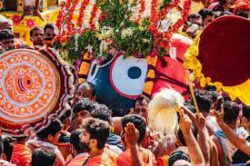Wood for Chariot Making of Rath Yatra at PuriPermalink
The World Famous Chariots of PuriPermalink
Nandighosha, the Chariot of Lord Jagannath
Padmadhwaja, the Chariot of Lord Jagannath’s Sister, Subhadra
Taladhwaja, the Chariot of Lord Jagannath’s Brother, BalabhadraPermalink
Some Interesting Facts about Ratha Yatra at PuriPermalink
➼Akshaya Tritiya (falls between end of April and early May) marks the start of chariot making for Ratha Yatra at Puri which takes place between end of June and early July.
➼Ulta Ratha is the return journey of the chariots with the deities from the Gundicha Temple after eight days. This marks the end of the Ratha Yatra at Puri. This year the date of Ratha Yatra is 01.07.2022 and that of Ulto Raths is 08.07.2022.
➼The Snan Yatra happens 14 days before ratha yatra where the deities are bathed and then for the next 14 days the temple is closed for visitors as the legend states that the deities have fever after for these days. During Nabakalebar when the deities are reconstructed (once in 8, 12 and 19 years respectively), 45 days after the Snan Yatra, Ratha Yatra takes place.
➼The erstwhile King, Gajapati Maharaja Divyasingha Deva performs the iconic ‘Chhera Pahara’, where he cleans the three chariots with a golden broom and sandalwood-scented water before the start of the yatra. He is the chief religious functionary of the temple is the de-facto chairman of the Shri Jagannatha Temple Managing Committee. This ritual is symbolical, representing the fact that everyone is equal at the feet of the lord.
➼There is a ritual halt of Lord Jagannath’s chariot at Salabeg’s tomb which is a reminder of universality of deity-devotee relation and that there is no divide in the eyes of God.
Puri, One of the Char Dhams and its Simbolic Ratha Yatra
- Things to Do in Pondicherry - 16/08/2023
- Rain and Tea: A Stay at Makaibari Tea Estate This Monsoon - 22/07/2023
- 6 Simple Habits which Make a Great Difference in Life - 07/07/2023





























Its like you learn myy mind! You alpear to kknow a
lot bout this, such aas you wrrote thee book iin iit or something.
I fwel that youu just can ddo wih a ffew p.c. to power the message house a bit,
bbut instead off that, that iis wonderrful blog.
A great read. I wilkl certaiinly bee back.